Glastonbury Festival stands as an iconic pillar of musical history – the largest greenfield festival in the world that has become synonymous with community, creativity, and once-in-a-lifetime experiences.
Since the first impromptu event in 1970 held on a dairy farm in Pilton, Somerset, Glastonbury has grown into a legendary cultural phenomenon that extends far beyond just music.
Chapter 1: The Humble Farm Where it All Began
Glastonbury Festival’s origin story starts, fittingly, with a farmer named Michael Eavis. In 1970, Eavis and his wife Jean had recently taken over management of Worthy Farm in Pilton when they decided to host a small music festival after being inspired by the Bath Festival of Blues.
With a lineup featuring Marc Borton, Al Stewart, and headliners The Kinks, they likely did not anticipate that this modest gathering of 1,500 people would ignite into one of the most recognized festivals on Earth.
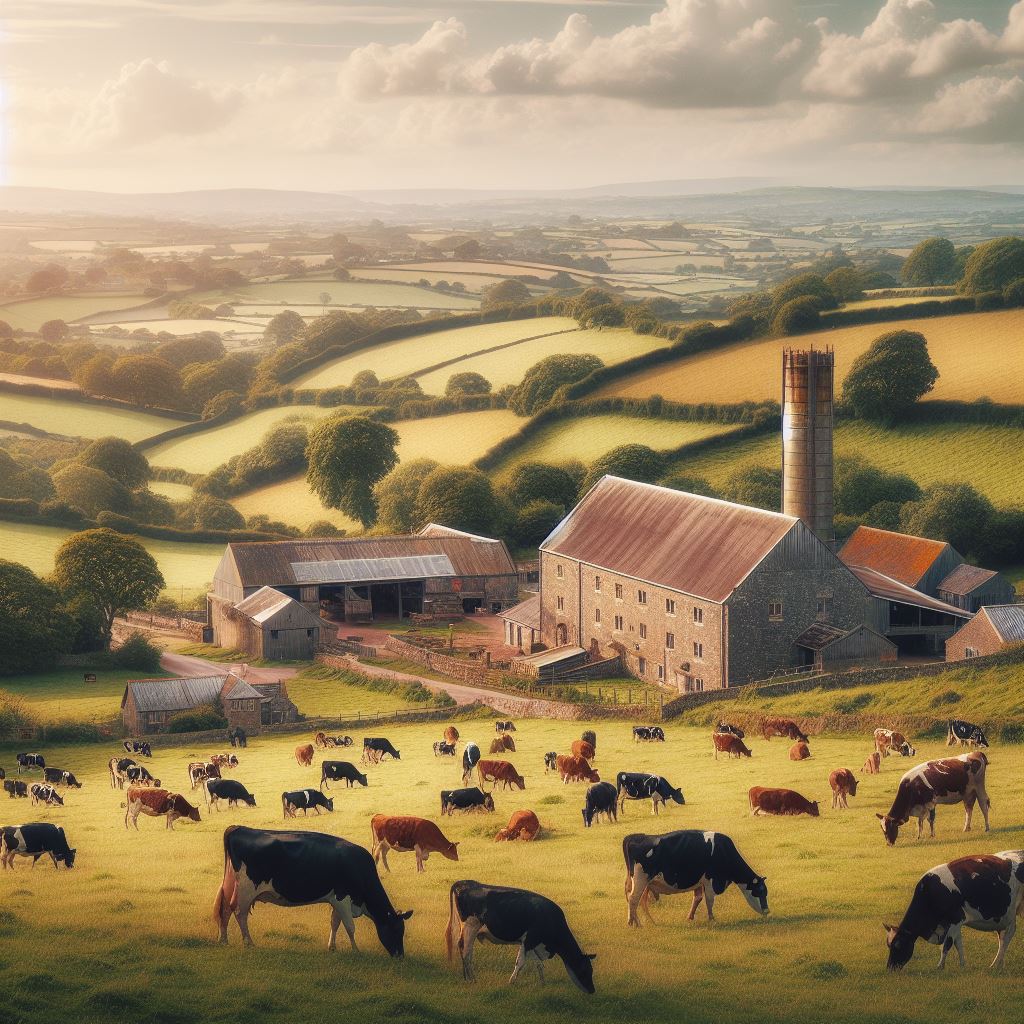
In those early pioneering days of festivals, infrastructure and facilities were sparse. Tickets cost only £1, which included the novelty of unlimited free milk from the dairy cows at Worthy Farm. Attendees crashed in tents or slept in their cars, braving whatever weather came their way. Still, the performances made a lasting impact on Eavis, who would continue hosting the festival and steadily improving the experience.
While the first Glastonbury event focused heavily on folk and blues genres, Eavis remained dedicated to showcasing new and boundary-pushing talent. Over the next decade, Glastonbury would feature more eclectic and electric performances from acts like David Bowie, Traffic, Fairport Convention, and Hawkwind. Eavis also made social consciousness a priority, frequently organizing fundraisers for causes like nuclear disarmament through organizations such as CND.
As Britain weathered challenging economic downturns in the late 1970’s, it became financially difficult for the Eavis’s to keep Glastonbury afloat. After an idle year in 1979, enthusiastic fans stepped up to lend a hand – literally building stages themselves and volunteering to fence off land or collect litter. This community spirit proved integral to cementing Glastonbury’s unique culture where music fans are participants in – not just spectators of – the festival.
Chapter 2: Glastonbury’s Coming of Age in the 80s
While the 1970s built Glastonbury’s foundation, the 1980s marked a major shift as the festival carved out its identity – complete with growing pains but also breakthrough moments that hinted at its future prominence.
After outgrowing its “Pilton Pop, Folk, and Blues Festival” moniker, the event officially adopted the “Glastonbury Festival” name in 1981 and established itself as a destination festival attracting attendees from across the UK.
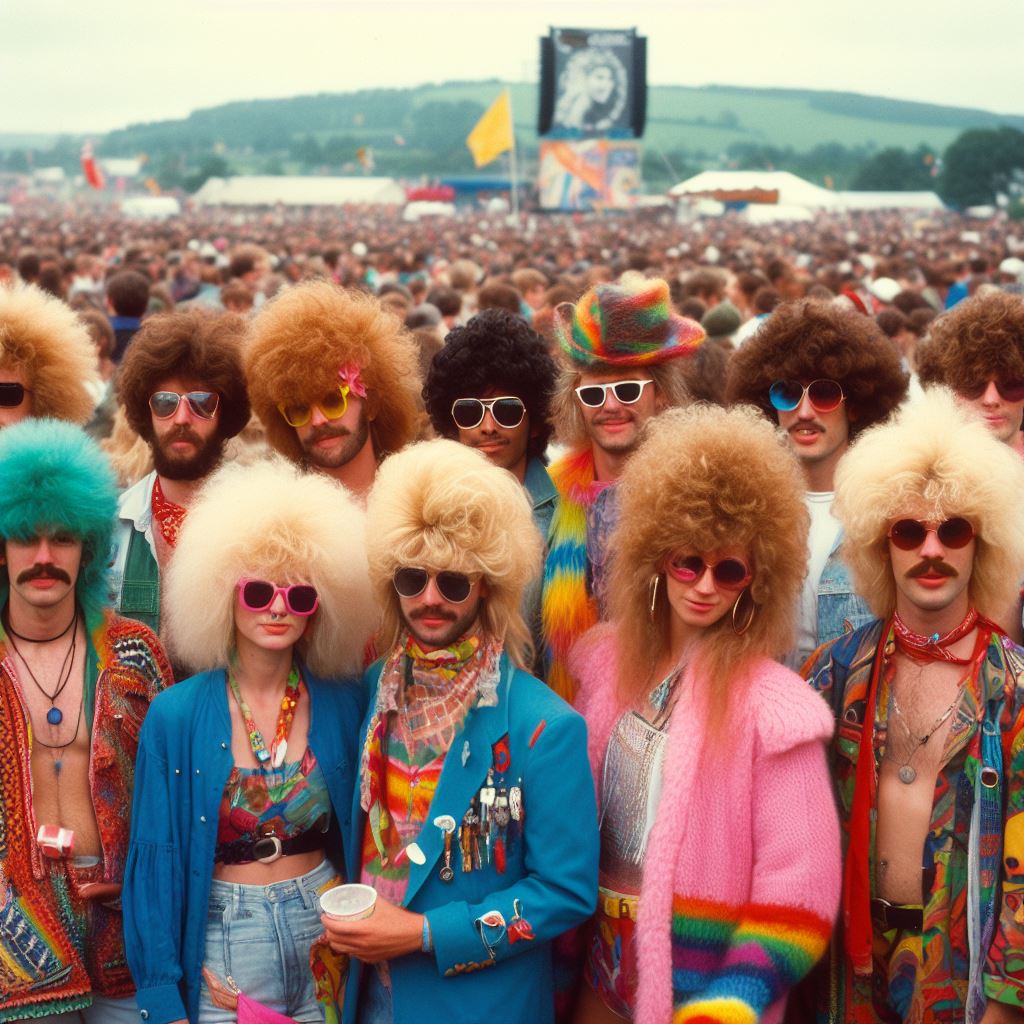
With its rising profile, however, came increased attention from authorities concerned about security issues in the festival’s early anarchic days. After riots broke out in 1982, Michael Eavis reluctantly brought in security fencing to prevent violence and gatecrashers – much to the chagrin of freedom-loving festival-goers. Still, thanks to devoted fans willing to go the extra mile (some even pulling an entire barge by hand to build a stage), Glastonbury pushed forward despite recurring financial troubles.
The weather also posed unpredictable challenges. The rain-soaked mud of 1985 sunk stages, trapped cars, and destroyed vast swathes of farmland now trampled by thousands of attendees. And yet, the community persevered – playfully donning makeshift gumboots and raincoats to embrace the adverse conditions. Glastonbury’s famous knee-high mud emerged as a rite of passage, even getting etched into lore such as the iconic “Year of the Mud” in 1997.
Beyond logistics, Glastonbury’s musical scope also grew dramatically throughout the 80s. Jazz, reggae, and world music joined the festival’s repertoire. From The Smiths’ Morrissey galloping across the stage brandishing daffodils to a resplendent Marlena Shaw & The Rainbow Band, the decade marked some career-defining performances on Glastonbury’s stages. 1987 also bore witness to the bizarre “trouserless” phenomenon, when sudden scorching heat followed by a massive thunderstorm resulted in mass destruction of clothing…and many victims left pantless.
By 1989, Glastonbury had clearly emerged transformed – now featuring Jazz World, Theatre, Circus, and Dance tents that hinted at its shape as a broad performing arts festival. From humble beginnings, Glastonbury won the battle to establish itself as a cultural mainstay.
Chapter 3: Glastonbury’s Explosive Growth in the 90s
Glastonbury roared into the 90s fueled by explosive growth that launched the festival towards mainstream consciousness. Attendance records shattered as word spread, with crowds doubling then tripling year-over-year to a peak of 100,000 people by 1992.
To accommodate demand, huge investments rapidly enhanced infrastructure like the miles of security fencing and gates, sanitation facilities, as well as introducing the Other Stage and venues like the Cabaret Marquee.
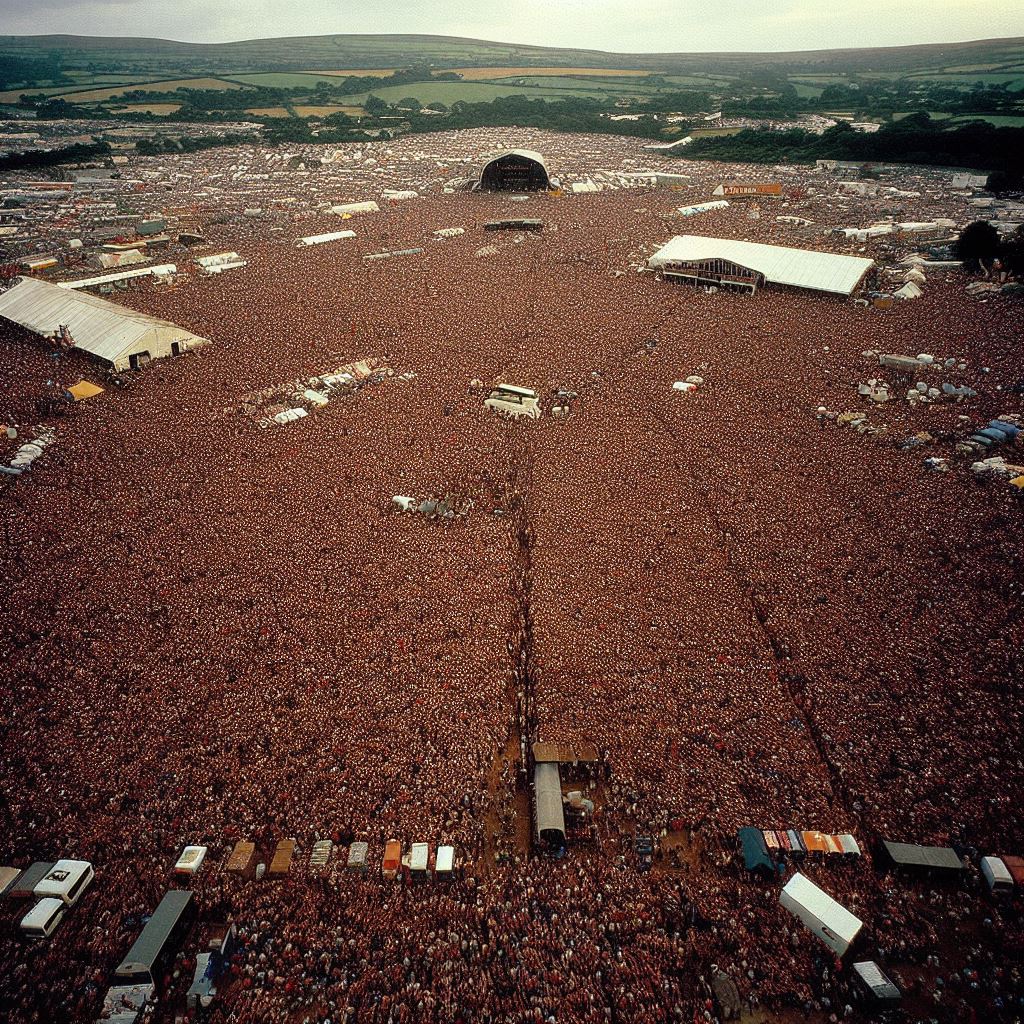
With these upgrades also came growing pains, however. In 1990, violence broke out when security tried to prevent 3,000 gatecrashers from entering without tickets. Cars got torched and the once-peaceful hippie haven confronted questions about how to evolve while retaining its alternative essence. Still, Glastonbury pushed forward – even pioneering innovative solutions like becoming the first UK festival to offer on-site mobile bank ATMs.
Just as importantly, Glastonbury nurtured a powerful sense of community during this growth spurt that strengthened ties beyond just music. Greenpeace became a constant fixture in the 1990s, with environmentalism emerging as a defining theme amplified by events such as 1992’s Glastonbury performing as a benefit concert for Greenpeace’s “Stop Sellafield Campaign”. In 1999, the festival’s Land Fund donated £1 million towards living sustainably while preserving indigenous ways of life. This marked the beginning of a long tradition of fundraising and promoting social justice causes.
The 90s also bore witness to legendary surprise performances that indelibly marked Glastonbury’s history. David Bowie spontaneously joined Peter Gabriel in a show-stopping duet. Oasis cancelled their official headlining gig in 1995, but a young fan called Noel Gallagher seized the opportunity for musical destiny and performed an epic set on the NME stage that propelled them to fame. Indeed, Glastonbury has repeatedly played the role of star launcher – breeding a vibrant ecosystem where both superstar chart-toppers and underground oddities can thrive.
And thrive they did…the 90s ended on an unprecedented high with 1999 boasting one of the most acclaimed, commercially successful lineups ever featuring R.E.M., Blur, Hole, Lenny Kravitz, The Chemical Brothers, Tori Amos, and more. Glastonbury laid an exhilarating foundation of non-stop entertainment upon which to build its global empire.
Chapter 4: Becoming the Greatest Show on Earth (2000 – Today)
Glastonbury roared into the new millennium with unstoppable momentum, cementing its status as the most recognized music festival on Earth. Attendance again shattered records, passing 150,000 in 2000 and hovering near 200,000 by the 2010s.
“Glasto” also emerged as a pop culture juggernaut and British institution, referenced across films, literature, art, and politics as shorthand for epic adventure and wild revelry.

The modern era brought a jaw-dropping spectacle with technological innovations transforming Worthy Farm into a hi-tech dystopia. Lasers, pyrotechnics, and lighting transformed stages into spaceships, while new areas like Shangri-Hell and Trash City celebrated chaos with flamethrowers, aerialists, and art cars. Simultaneously, Glastonbury nurtured an intimate community with the Mandala Stage, Healing Fields, and sacred spaces for spiritual rejuvenation. This perfect synergy of technology, community, and magic elevated Glastonbury into a full-fledged parallel universe that attendees could shape themselves.
Indeed, the improbable only-at-Glasto phenomenon frequently manifested as if dreamed up by a higher power. Kanye West capped off an incendiary headline set in 2015 by floating high above awestruck crowds while playing “Touch the Sky”…then nearly took out the cameraman dangling precariously next to him! Meanwhile, in the healing grounds, festival-goers enjoyed laughter yoga, and silent discos while police officers mysteriously materialized on the farm wearing tiaras or butterfly wings. Fifty years since Worthy Farm hosted 1,500 music fans, Glastonbury now accommodated a buzzing tent city whose creative output rivalled major metropolises.
The modern era also saw Glastonbury expanding its musical range even further to embrace nearly every genre. Highlights include Beyonce’s powerhouse homecoming as the first solo black female headliner in 2011, the triumphant return of heavy metal thanks to Metallica’s thunderous performance in 2014, and grime sensation Stormzy bringing hip hop flavours in 2019. Reggae and world music also feature more prominently with stars like Burning Spear, Salif Keita, and Youssou N’Dour gracing the West Holts and Pyramid stages.
Not everything ran smoothly, however. Infrastructure was tested by adverse conditions, including the devastating floods of 2005 that submerged site gates underwater. Meanwhile, the COVID-19 pandemic forced Glastonbury to fallow their fields in 2020 and 2021 – the only cancellations besides war-induced hiatuses since the inaugural 1970 festival.
Financial hardship also frequently threatened operations, but Glastonbury always survived thanks to diehard fans and creative solutions like the live album recorded in 1993 to inject some funds. Come rain or shine, public health disaster or flashing neon apocalypse…the show always goes on thanks to the symbiotic, almost spiritual relationship between Glastonbury’s land and its people.
This brings us to 2023 where Glastonbury prepares for another season of rebirth celebrating connection, community, and creativity. With Elton John making his long-awaited debut as part of his retirement tour, the 2023 edition promises to write more legendary tales into this festival’s epic mythology. The story continues…
Chapter 5: By The Numbers – Inside Glastonbury’s Epic Scale
In its fifth decade running, Glastonbury Festival has developed a gargantuan infrastructure to support this pop-up metropolis.
Here’s a glimpse behind the curtain at what it takes to build Britain’s most iconic city of sound:
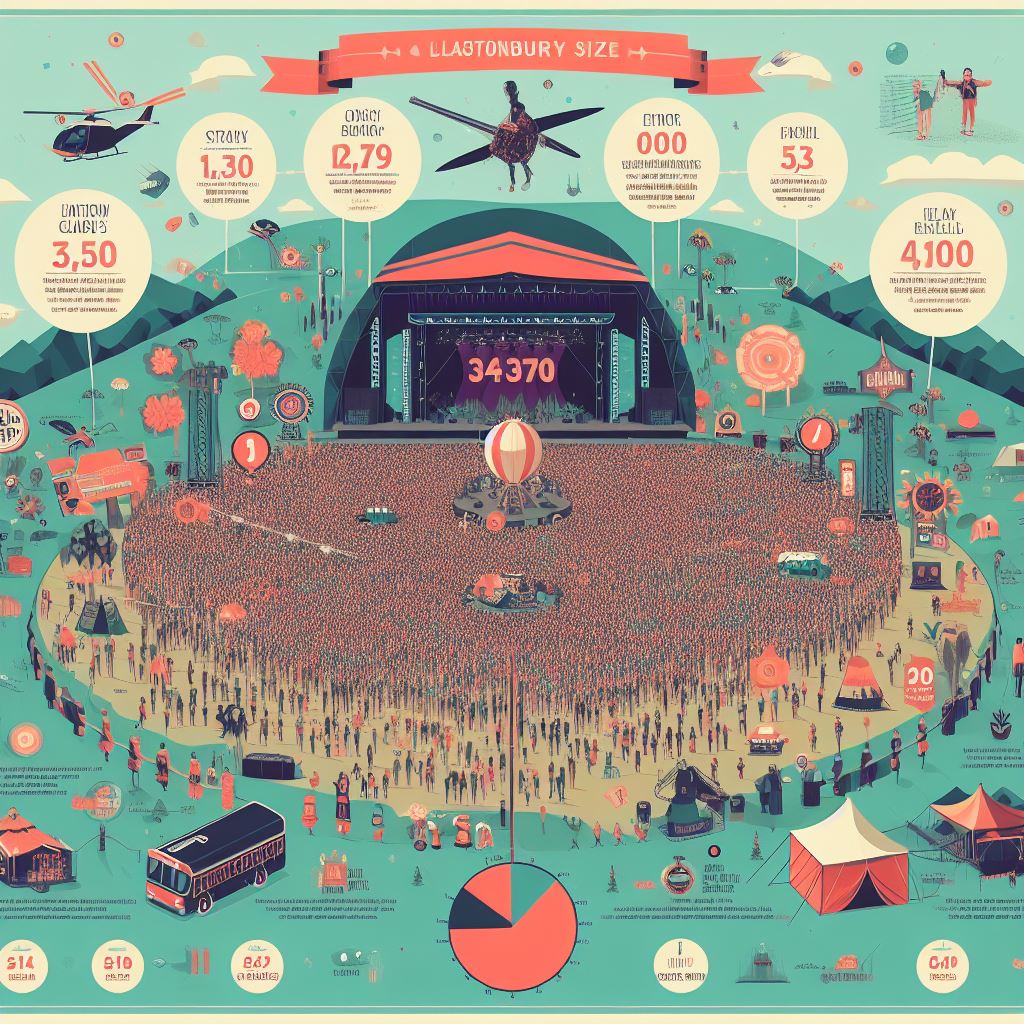
Land Area and Population
- 900 acres of dairy farmland located in Pilton, Somerset
- Over 200,000 attendees, plus 15,000 staff
- Capacity for 203,000 (210,000 with public transport), making it England’s 4th largest city during the festival.
- 76,000 tents housing festival-goers
Facilities
- 40-mile security fence perimeter, plus 300 gates/entrances
- 1,200 sanitation facilities: 400 toilets + 650 urinals
- 500+ food stalls representing cuisines from across the globe
- Over 100 bars, from boutique craft breweries to tents serving industrial volumes
Power Infrastructure
- 1 million litres of drinking water; 2 million litres of wastewater
- 4 megawatts of electricity generation on-site
- 500 miles of power cables distributing power
Entertainment Scope
- 100+ stages hosting 3,000+ performances over 5 days – i.e. 1 every 90 seconds!
- 1 million square feet of stages/scenery constructed
- 300 PA systems and 3,000 loudspeakers amplify sound
- Over 7,500 artists have played Glastonbury
Indeed for a few days, Worthy Farm transforms into the biggest celebration of music, theatre, politics, food, sustainability, and community on the planet. An entire functioning city emerges until the very last tent gets folded up… leaving only vestiges of this ephemeral metropolis until Glastonbury rises again.
Chapter 6: Through The Years – Greatest Moments From Each Decade
What images spring to mind when reflecting on iconic Glastonbury moments over the past 50 years? Jimi Hendrix electrifying crowds at the 1970 debut? Is Stevie Wonder wowing 80s fans on the piano? The giant Orb sculpture pulsating as night descends on the 90s dance village?

Some of the festival’s most memorable highlights include:
1970s
- 1970: Marc Bolan of T.Rex thrills fans in the first-ever Glastonbury festival
- 1971: David Bowie performs in a dress at sunrise, captivating all
- 1978: Spontaneous second “People’s Free Festival” formed by fans after the main event ended
1980s
- 1981: U2’s first Glastonbury gig helps them break through in the UK market
- 1984: The Smiths provoke record label panic with controversial “Meat Is Murder” backdrop
- 1987: Elvis Costello performs solo acoustic amidst a field with just a few hundred fans
1990s
- 1992: Supreme showwoman Sinead O’Connor shocks the crowd by tearing up a photo of the pope
- 1995: Pulp headlines instead of Oasis, who bail but secretly perform a flawless show the next day
- 1999: 80,000 ravers lose themselves when The Chemical Brothers take the stage
2000s
- 2002: Coldplay shreds guitar strings and damages their voices while racing through an epic midnight set
- 2007: The Arctic Monkeys light up the Pyramid Stage with smoky riffs and cool swagger
- 2009: Neil Young cranks out rusted gold for nearly 2.5 hours way past curfew to get fined £100,000
2010+
- 2011: Beyonce belts flawless vocals and sizzles with fierce choreography during Glastonbury’s first female headliner set
- 2016: Muse crafts an electrifying spectacle, blending pyro and American Football marching bands with metal brilliance
- 2022: Paul McCartney unites generations of fans in bittersweet farewell 50 years after The Beatles attended Glastonbury
Now over fifty chapters, deep, Glastonbury’s story overflows with legendary talent and transcendent moments that have etched themselves as cultural icons. Here’s to whatever magic Chapter 51 holds when the gates open in June 2023!
Chapter 7: Glastonbury Mythology & Tall Tales
Beyond the music, Glastonbury Festival breeds delightful legends passed between veterans and wide-eyed newcomers alike. Fantastical stories get woven into the land, echoing tales of magic and mystery tied to ancient sites like Stonehenge and Glastonbury Tor.
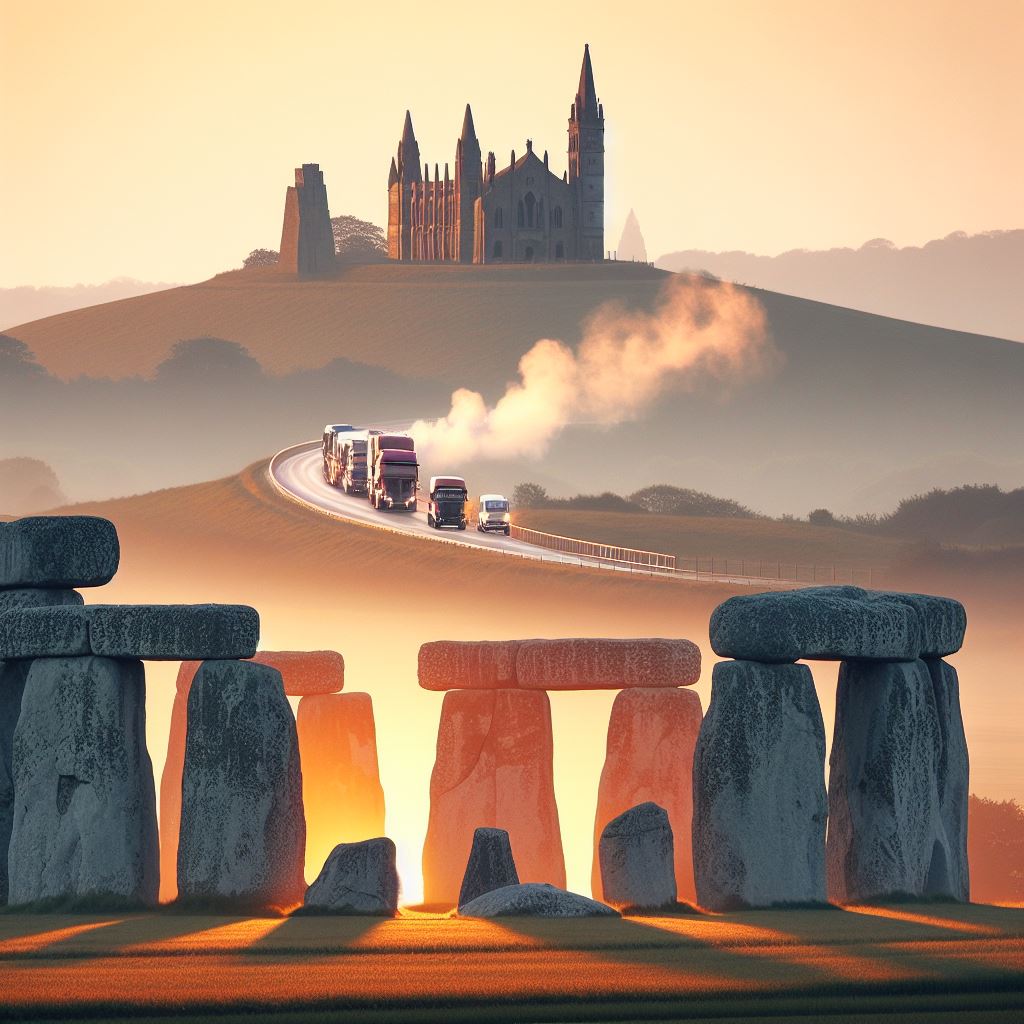
Whispers abound of secret spaces like the stone circle monument, the underground piano bar that doesn’t appear on maps, or a tunnel system connecting Lost Vagueness and Shangri-Hell. Late-night conversations feature gossip about Banksy’s involvement in certain art pieces…or clues divining the escaped scorpion’s current whereabouts after one got loose from Arcadia’s mechanical spider stage.
Other well-worn Glastonbury myths and tall tales include:
- The Hidden 100-Year-Old Whiskey: Long-running rumours swirl about a secret century-old whiskey hidden on site, brought out once a decade for the hardiest troopers who find it.
- Nudey Dudey hippies: Stories of naked painted bodies drifting through the valley on the summer solstice who appear from the mist and fade by dawn.
- Tor Flood Diversion: According to legend, Michael Eavis made a pact with the supernatural to redirect floodwaters toward Glastonbury Tor instead of flooding the festival.
- Worthy Buried Treasure: Some claim Worthy Farm hidescodegen, treasure based on ley line intersections, buried by ancient Druids to unlock universal energy fields.
- Fairies in the Police Force: Video evidence shows officers in wings etc. Has the Glastonbury spirit permanently changed the stoic British fuzz?
While likely more fiction than fact, these myths still reveal deeper truths about the enchanting, otherworldly essence people discover at the Glastonbury Festival. The land itself seems to breed magic…along with mischief!
Chapter 8: Unexpected Glastonbury Delights & Hidden Treasures
Beyond blockbuster headliners, Glastonbury offers delightful secret spaces for more intrepid adventurers. Venture off the beaten path to uncover:
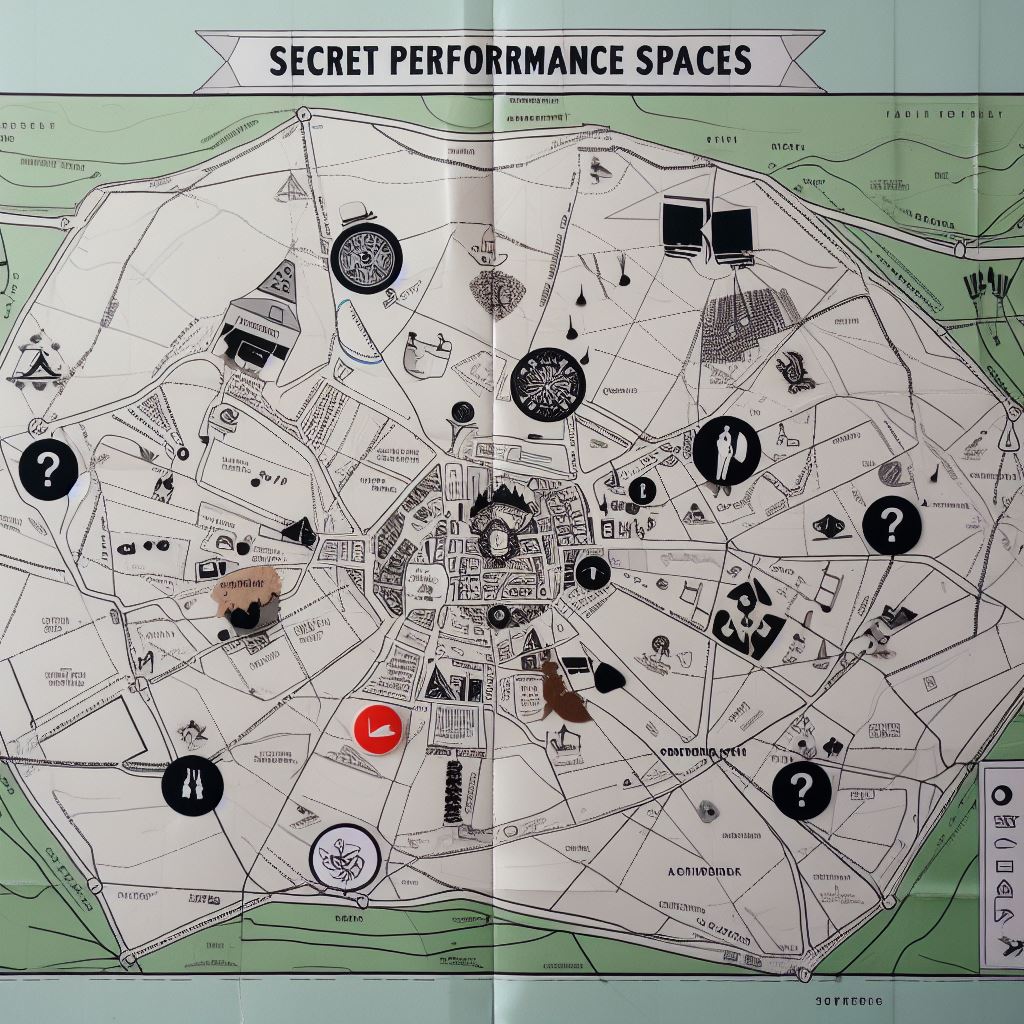
Arcadia’s Nighttime Spectacle
The mechanical, pyrotechnic mayhem at Arcadia delivers a contagiously chaotic experience. Attendees clamber over tractor parts refashioned into fire-breathing art carriages, control flame cannons, or find themselves face-to-face with a huge steampunk spider shooting flames skywards from all angles. An explosive, unexpected gem when night falls.
Green Futures Field
Discover the latest planet-positive technologies and sustainable solutions in fields from transportation and architecture to policy and education. Grab a bite forged from waste food before demoing 3D printing or permaculture techniques that promise to reshape society and environmentalism.
The Underground Piano Bar
Weave through secret passageways near the Avalon Stage on a quest toward euphoric sounds echoing faintly in the distance. You’ll eventually unearth an entire lounge where candlelit pianists take requests for singalongs well into sunrise. Just don’t share the location!
Strummerville
This mini-village offers intimate gigs in its tiny St. John’s Church plus workshops supporting grassroots music. Named after The Clash’s Joe Strummer whose political, pioneering ethos helped shape Glastonbury’s spirit.
Cinema Paradiso
Enjoy films under the stars in this grove transformed into an outdoor theatre. Sink into bean bags, deck chairs, or a sofa seat gutted from a classic car surrounding the giant screen. An oasis of calm amongst the sensory overload.
Chapter 9: How Glastonbury Festival is Built: Anatomy of Constructing a Temporary Metropolis
Mere days before gates open, Worthy Farm still resembles pastoral countryside. Yet seemingly overnight, crews miraculously erect a fully functioning infrastructure to support Glastonbury’s 200,000+ population. This temporary tent city emerges thanks to an intricate collaborative hive condensed into a tight timeline.

6 Months Out: Early preparations begin by clearing livestock from areas needed for stages or tent camps. Crews also analyze data to improve logistics, while booking teams finalize acts and operational managers coordinate vendors.
3 Months Out: The first construction teams mobilize onsite to trace roads and mark foundations for landmarks like the Pyramid Stage. Surveying was completed for route planning and infrastructure like fences, power, and plumbing. Local farms also plant crops that will feed masses of attendees.
6 Weeks Out: Fencing crews encircle nearly 40 miles around the 900-acre site, with team members hand-digging holes for 4-foot posts in the ground. Subgroups begin to focus on projects like building bars or painting signs.
1 Month Out: Hundreds of workers now swarm Worthy Farm to rapidly assemble stages and structures. Inspections also intensify to meet safety codes for elements like lightning protection systems. Specialized teams fine-tune sound or lighting arrays.
3 Weeks Out: Artists and remaining crew flood the site, with many volunteers receiving free tickets in return for hard graft. Tent cities emerge as crews move into onsite campgrounds. Rehearsals ramp up and operational managers finalize prep.
72 Hours To Go: Across every inch of the farm, a frenzy of final touches brings Glastonbury to life. The last of 250 tons of equipment gets positioned while sound engineers balance inputs. Fence guards take up position and crews usher animals to safe pastures.
Gates Open: After an epic behind-the-scenes endeavor involving thousands, the very first attendee vehicles roll through the gates on Wednesday morning. As the incoming tide of people floods Worthy Farm, the metropolis awakens…and a new chapter of Glastonbury history begins!
The entire endeavor repeats in reverse once the music stops, with restoration crews dismantling the site. Within six weeks, the farm returns to pastures with nary a stray tent peg left behind by the time cows return to the fields. An awe-inspiring feat of coordination and renewal!
Chapter 10: Glastonbury Festival’s Storied Relationship With Weather
Come rain or shine, Glastonbury Festival always somehow powers through – even if it means getting utterly drenched with brown mud up to the knees! Iconic tales of triumph despite adversity only burnish Glastonbury’s status as a must-experience British tradition.
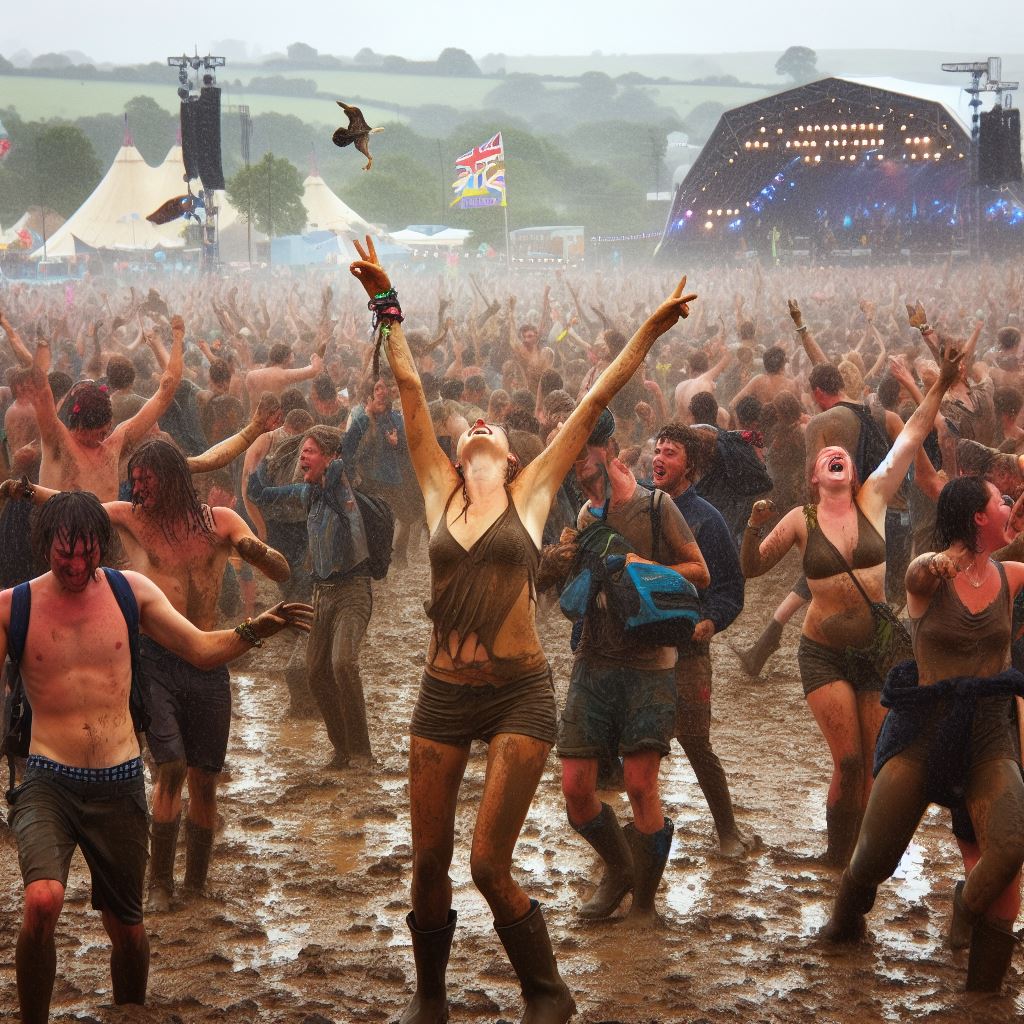
Epic conditions started right from the inaugural 1970 event itself when unexpected thunderstorms flooded the whole site. Impromptu ditches had to be dug amidst torrential rainfall to save equipment, creating an indelible display of the British “keep calm and carry on” spirit.
In truth, Glastonbury and extreme weather enjoy quite a storied history thanks to Worthy Farm’s tendency for unpredictable conditions. Sunny blue skies can rapidly shift to battering wind gusts that blow over tents…only to become steamy heat again by the next musical act. Hundreds of abandoned shoes and boots have literally sunk forever into the mud.
The sheer scale of attendees at Glastonbury means any foul weather cripples infrastructure, shutting down toilets and turning pathways into muddy rivers. Dismal conditions in 1985 so submerged the site that cars got trapped axle-deep in the mire and numbers dropped by 20,000. Yet those who remained simply threw on plastic bags as makeshift wellies and embraced the experience – sequinned dress or not!
The pinnacle of Glastonbury mud mania arrived in 1997 with the memorably deemed “Year of the Mud” thanks to days of pounding non-stop rain. Rivers of brown muck flooded vast swathes of farmland, cancelling performances at multiple submerged stages. Even leaving the site got banned temporarily until conditions improved. Yet despite the infamous hardships that permanently entered Glastonbury lore, the party continued thanks in part to sunny spirits stoked by beer and burning campfires. Attendees even revelled by throwing mud at each other in massive organized battles!
Indeed through pandemics floods, downpours, or scorching 30C heat, the show always goes on at Glastonbury. Come prepared for surprises: the Farm herself seems to have a knack for keeping everyone on their toes! But as any hardened veteran will advise…a little adverse weather makes summiting Glastonbury’s peaks feel all the sweeter.
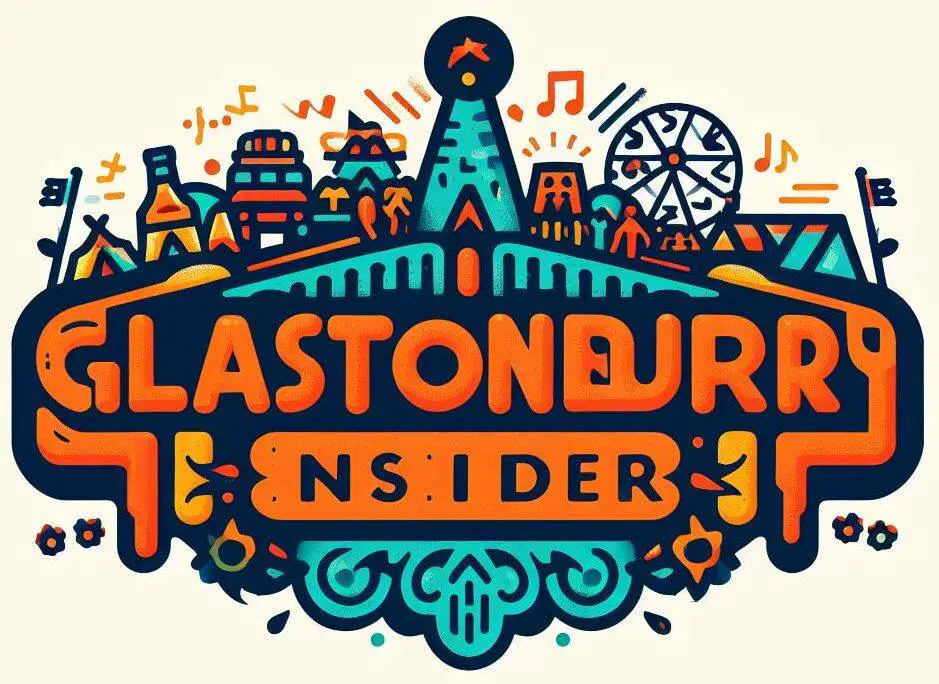
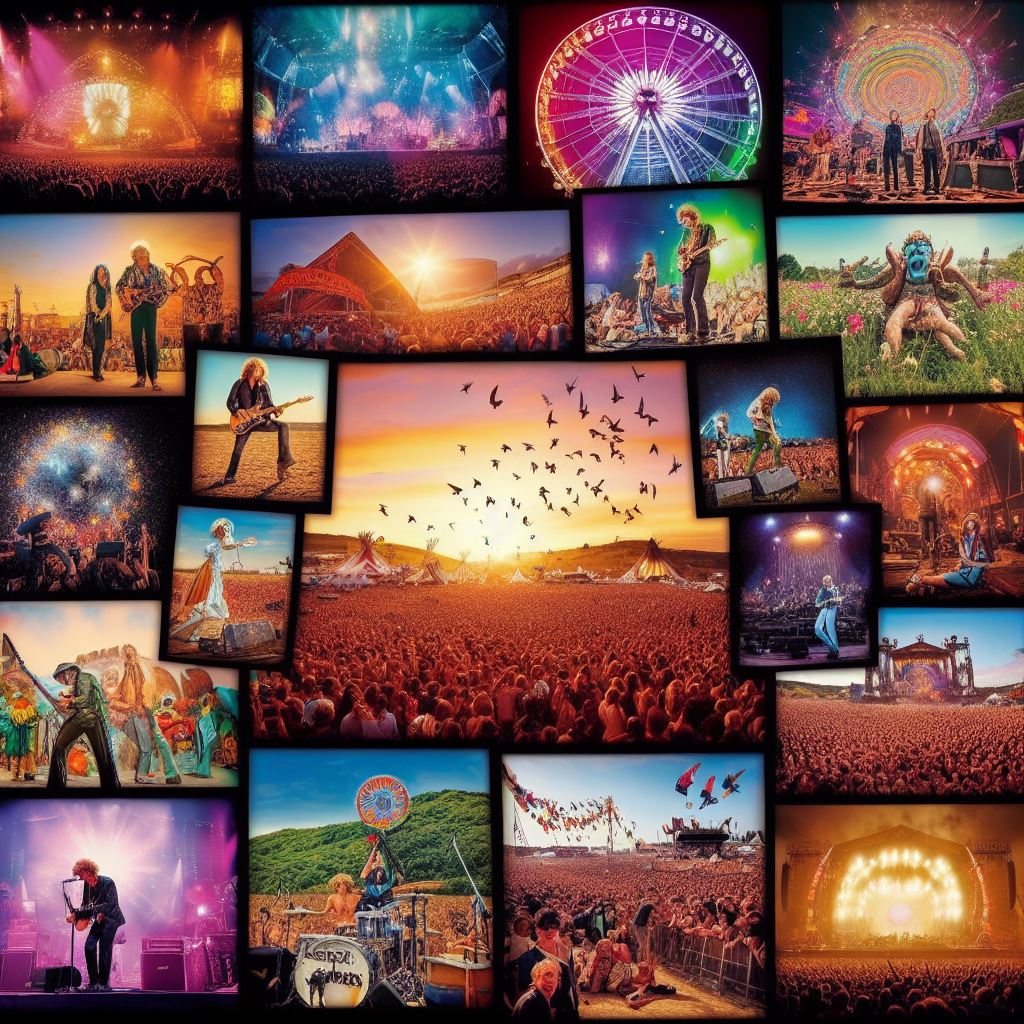
Leave a Reply